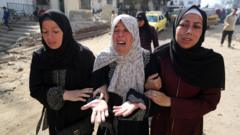How Many Lives Were Lost in Recent Israeli Strikes in Gaza?

The Ongoing Humanitarian Crisis in Gaza: A Deep Dive into Recent Events
The recent escalation of violence in Gaza has resulted in a devastating humanitarian crisis, drawing international attention and concern. With reports of at least 81 Palestinians killed and over 400 injured in a mere 24 hours, the situation has reached a critical point. This article explores the latest developments, the reactions from various stakeholders, and the implications for peace in the region.
Understanding the Current Context
The current wave of violence is part of a larger conflict that has persisted for decades, rooted in deep-seated political, territorial, and cultural disputes. The most recent escalation began on October 7, 2023, when Hamas launched a surprise attack on Israel, resulting in significant casualties, including 1,200 Israeli fatalities and 251 individuals taken hostage.
In the aftermath of this attack, the Israel Defense Forces (IDF) initiated extensive airstrikes across Gaza, targeting what they identified as Hamas strongholds. However, the strikes have resulted in significant civilian casualties, with hospitals and humanitarian organizations reporting high numbers of deaths and injuries among innocent civilians, including women and children.
The Human Toll of Airstrikes
On Saturday, reports emerged of a particularly deadly strike near a stadium in Gaza City, where many displaced individuals had sought refuge. Witness accounts describe horrific scenes as families dug through rubble, searching for loved ones. The Hamas-run health ministry reported that many of the deceased were children, raising urgent questions about the targeting of civilian populations.
- 81 Palestinians killed in 24 hours, according to health ministry.
- 11 fatalities, including children, from a strike near Palestine Stadium.
- Strikes in al-Mawasi area resulted in additional civilian deaths.
- Emergency services face immense difficulties reaching victims.
The Role of International Mediators
Amid the escalating violence, international mediators, including Qatari officials, have intensified efforts to broker a ceasefire. U.S. President Donald Trump expressed optimism about the possibility of achieving a truce within the coming week. However, negotiations remain fraught with challenges. The collapse of a two-month ceasefire earlier this year highlights the fragility of any agreements reached.
The Failed Ceasefire and Its Implications
The ceasefire agreement established in January was designed to unfold in three stages. The first stage aimed at halting hostilities, while the subsequent stages would address the release of hostages and the withdrawal of Israeli forces from Gaza. Unfortunately, tensions flared once more, leading to the current escalation.
Senior Hamas officials have indicated that while mediators are working diligently to establish a new ceasefire, discussions with Israel remain stalled. The complexity of the situation is further compounded by differing narratives about the conflict, each side blaming the other for the continuation of violence.
Public Response and Civilian Impact
As the violence continues, public sentiment is shifting. In Israel, rallies have emerged calling for the release of hostages held by Hamas and an end to the fighting. Organizers emphasize the urgency of bringing everyone home safely. The humanitarian crisis in Gaza, however, is drawing attention from global human rights organizations, urging an immediate cessation of hostilities to protect civilians.
Voices from the Ground
Witnesses from Gaza have shared harrowing accounts of their experiences during the airstrikes. Many describe an atmosphere of fear and confusion, with civilians caught in the crossfire of military actions. Ahmed Qishawi, a local resident, described the chaos that erupted during a recent attack:
“We were sitting when we suddenly heard a huge explosion… There are only civilian residents, children, who were targeted with no mercy.”
Such sentiments reflect the broader despair among Gaza's population, where the conflict has created an environment of uncertainty and loss.
The Challenges of Humanitarian Aid
The health ministry in Gaza has reported that emergency services are struggling to reach victims trapped beneath the rubble due to damaged infrastructure and ongoing airstrikes. The situation is dire, with hospitals overwhelmed and resources rapidly dwindling. Humanitarian organizations are calling for safe passage for aid, yet the conflict complicates these efforts.
Key Challenges Faced by Aid Organizations
- Restricted access to affected areas due to ongoing military operations.
- Overwhelmed medical facilities unable to cope with the influx of casualties.
- Insufficient supplies of medical equipment and essential resources.
- Difficulty in coordinating with local authorities amidst the chaos.
The Path Forward: Seeking Solutions
The ongoing conflict in Gaza presents a complex challenge for local and international actors alike. To foster a sustainable resolution, several key steps need to be taken:
1. Establishing a Ceasefire
A ceasefire is essential to halt the immediate violence and protect civilians. International mediators must work tirelessly to facilitate negotiations and ensure both parties commit to a lasting peace.
2. Addressing Humanitarian Needs
Ensuring that humanitarian aid reaches those in need is critical. Safe corridors must be established to allow for the delivery of medical supplies, food, and other essential resources.
3. Engaging in Long-term Peace Talks
Beyond the immediate cessation of hostilities, long-term peace talks must address the underlying issues driving the conflict, including territorial disputes, political representation, and economic stability.
Conclusion: A Call for Humanity
The situation in Gaza is a stark reminder of the human cost of conflict. Each statistic represents a life lost, a family shattered, and a community in despair. As the world watches, it is imperative that all stakeholders prioritize human life over political agendas. A collective effort is needed to bring about an end to the violence and pave the way for a peaceful resolution.
In these challenging times, it is our shared responsibility to advocate for those who cannot advocate for themselves. Let us hope for a ceasefire and a future where dialogue replaces violence. How can we as a global community ensure that the voices of the innocent are heard amidst the chaos?
Frequently Asked Questions
What triggered the recent escalation in Gaza?
The recent escalation began with a surprise attack by Hamas on Israel on October 7, 2023, prompting extensive Israeli airstrikes across Gaza in retaliation.
How many casualties have been reported so far?
As of the latest reports, over 81 Palestinians have been killed and more than 400 injured within a 24-hour period due to Israeli strikes.
What efforts are being made to broker a ceasefire?
International mediators, including Qatari officials, are intensifying their efforts to negotiate a ceasefire, with hopes for an agreement in the upcoming week.
What challenges do humanitarian organizations face in Gaza?
Humanitarian organizations in Gaza are struggling with restricted access to affected areas, overwhelmed medical facilities, and insufficient supplies of essential resources.
What can be done to help civilians affected by the conflict?
Efforts should focus on establishing safe corridors for humanitarian aid, advocating for a ceasefire, and addressing the long-term political issues contributing to the violence.
As the world watches the ongoing humanitarian crisis unfold, what roles can we play to foster peace and support the affected populations? #GazaCrisis #HumanRights #PeaceInitiative
Published: 2025-06-28 19:27:08 | Category: world



